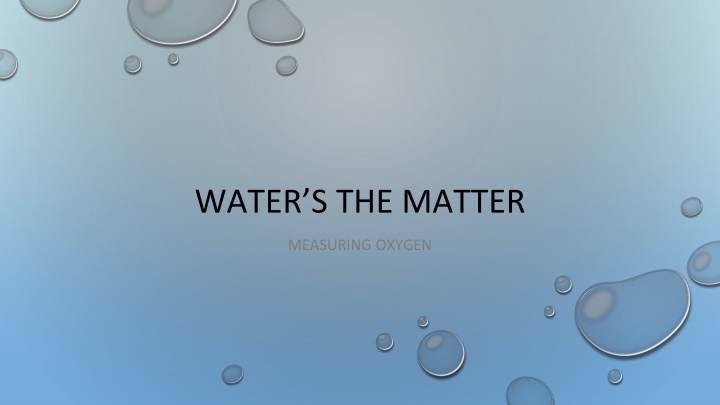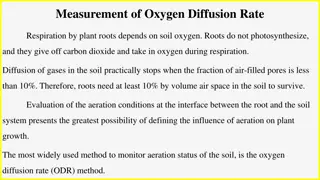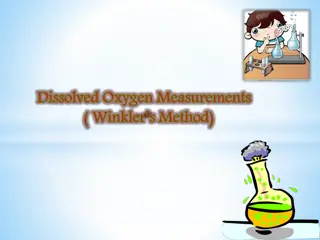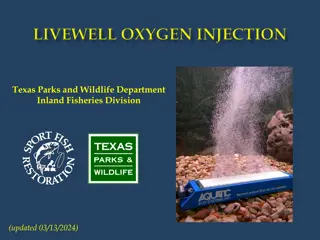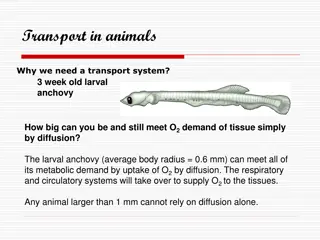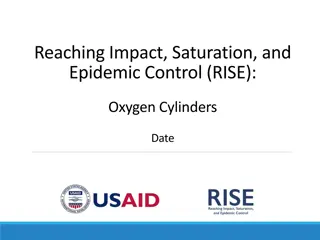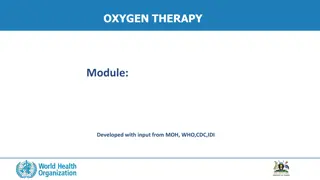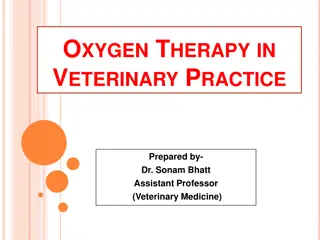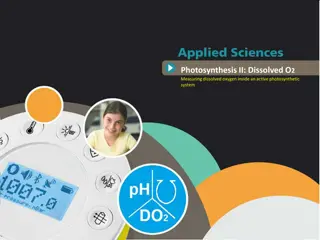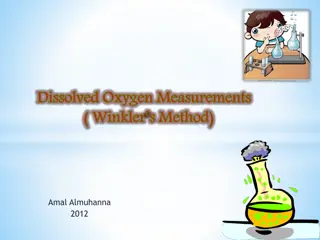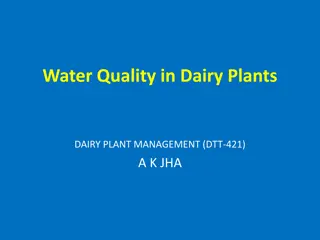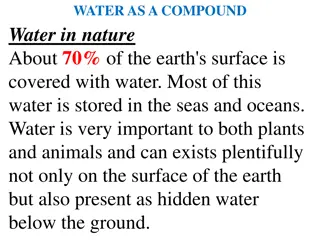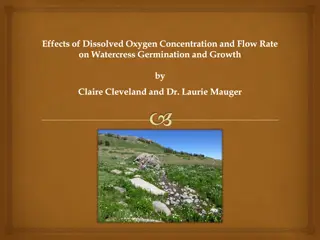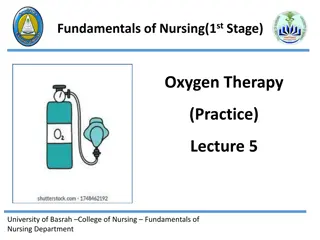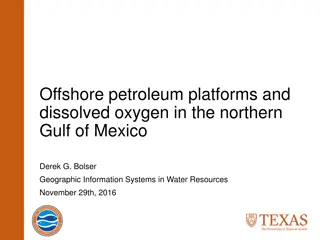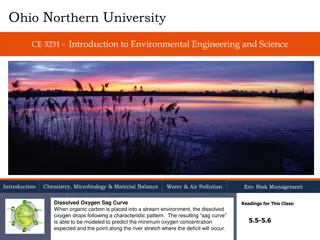Dissolved Oxygen in Water: Importance and Impact
Delve into the world of dissolved oxygen in water, understanding its significance in measuring water quality in aquatic environments. Discover factors affecting dissolved oxygen levels, interpret data, and explore the impact of human activities on water quality.
Download Presentation

Please find below an Image/Link to download the presentation.
The content on the website is provided AS IS for your information and personal use only. It may not be sold, licensed, or shared on other websites without obtaining consent from the author.If you encounter any issues during the download, it is possible that the publisher has removed the file from their server.
You are allowed to download the files provided on this website for personal or commercial use, subject to the condition that they are used lawfully. All files are the property of their respective owners.
The content on the website is provided AS IS for your information and personal use only. It may not be sold, licensed, or shared on other websites without obtaining consent from the author.
E N D
Presentation Transcript
WATERS THE MATTER MEASURING OXYGEN
NAVIGATION TABLE Water s the Matter: Measuring Oxygen Pre-Test Introduction Lesson Case Study Activity Self Study Game Post-Test
Measuring Oxygen Pre- Test Google Assessment
Measuring Oxygen Introduction Introduction
Introduction Measuring Oxygen WHAT DO YOU NEED TO SURVIVE? When asked this question, you might come up with a list of things like water, oxygen, food, and shelter. Most people understand that we need oxygen to breathe and we get that from the atmosphere. If we asked the same question about a fish, what would our list look like? Do fish need oxygen? Of course, they do! But where and how do they get that oxygen? A whale shark, the largest species of fish. Image from: https://en.wikipedia.org/wiki/File:Whale_shark_Georgia_aquarium.jpg
Introduction Measuring Oxygen IS THERE OXYGEN IN WATER? Absolutely! Living organisms in lakes, rivers, streams, and oceans require oxygen to survive! Oxygen that is in the water is one of the most important factors in an aquatic environment.
Introduction Measuring Oxygen In this lesson, you will explore the concept of dissolved oxygen in water and discover how it can affect water quality.
Measuring Oxygen Objectives After completing this module, you will be able to: Understand the importance of dissolved oxygen in measuring water quality in bodies of water. Describe the factors that change the dissolved oxygen level in bodies of water. Interpret dissolved oxygen data and understand how changes in dissolved oxygen affect the organisms living in the water. Model the effect of human activity on the dissolved oxygen content of water.
Measuring Oxygen Lesson Lesson
Lesson Measuring Oxygen DISSOLVED OXYGEN (DO) IN WATER Dissolved oxygen (DO) is the amount of oxygen that is present in water. You know that the chemical formula for water is H2O, where the H stands for hydrogen, and the O stands for oxygen. However, the oxygen in the molecular structure of water is NOT what we are referring to when we talk about dissolved oxygen. A small amount of oxygen, about ten molecules of oxygen per million molecules of water, is actually dissolved in the water. Consider the following: if you put salt in a glass of water and then stir this solution, the salt disappears. However, the salt is still there. If you taste the water, it is salty. A similar thing happens with oxygen in water! Molecules of water trap molecules of oxygen and keep it in a dissolved form.
Lesson Measuring Oxygen DISSOLVED OXYGEN (DO) IN WATER Just like humans, aquatic organisms need a certain amount of oxygen to survive. Fish and some aquatic insects have gills; gills allow these organisms to remove some of the dissolved oxygen from the water. Most organisms must receive a constant supply of oxygen, if these organisms do not receive oxygen they will soon die. Remember, our definition of water quality is a measure of the suitability of water for a particular use based on selected physical, chemical, and biological characteristics. Thus, if we are looking at the usefulness of water for sustaining living organisms, dissolved oxygen would be a key component of that water s quality. Salmon need oxygen rich water like the Ebright Creek in Washington. Source: Roger Tabor, USFWS
Lesson Measuring Oxygen IS THE AMOUNT OF DISSOLVED OXYGEN IN EACH OF THESE BODIES OF WATER DIFFERENT? White River in Indianapolis Image from: https://commons.wikimedia.org/wiki/File:WhiteRiverIndy_02.JPG#file Buffalo Bayou in Houston, Texas Image from: https://en.wikipedia.org/wiki/Buffalo_Bayou#/media/File:Buffalo_Bayou_looking_towards_Downtown_Houston.jpg Yes, there is a huge difference! The whitewater (left image above) probably contains as much oxygen as water can hold, while the bayou (right image above) contains very little. There are several reasons that the amount of dissolved oxygen is different in these two markedly different bodies of water; these reasons will be explained in the presentation portion of this unit.
Lesson Measuring Oxygen IS THE AMOUNT OF DISSOLVED OXYGEN IN EACH OF THESE BODIES OF WATER DIFFERENT? Most aquatic organisms, just like land dwelling animals, need to "breathe" oxygen to survive. Organisms must have a minimum amount of oxygen to survive. Unlike an increase in water temperature which can stress or even kill aquatic organisms, an increase in dissolved oxygen is not harmful. Although, there is a minimum amount of dissolved oxygen required in water for organisms to survive, there is no maximum amount or upper limit for dissolved oxygen. Water can have too many hydrogen ions, nitrates, or heavy metals dissolved in it, but, in terms of dissolved oxygen, "you can't have too much of a good thing". A catfish that can survive in relatively low dissolved oxygen environments (e.g. a bayou), can also tolerate being in an environment having high levels of dissolved oxygen (e.g. a fast moving, whitewater stream). Unfortunately, a trout living in fast moving, whitewater with high dissolved oxygen content cannot tolerate the low dissolved oxygen levels of a bayou.
Lesson Measuring Oxygen HOW CAN OXYGEN BE IN THE WATER? Water, like air, is a mixture of compounds. Air consists of mostly nitrogen, about 78%, and some oxygen, about 21%. Water is also a mixture. While the overwhelming majority of water is composed of water (H2O) molecules, gases become trapped among these water molecules. Remember our example of mixing salt in water from earlier in this passage? If you mix salt and water, the salt will disappear as it dissolves in the water. In a similar manner, oxygen dissolves in water. When oxygen molecules are mixed with water molecules, attractive forces suspend the oxygen molecules between water molecules. The attractive forces keep the oxygen together with the water molecules and prevent its escape from the water.
Lesson Measuring Oxygen HOW CAN OXYGEN BE IN THE WATER? Mammals that live on land have lungs that are adapted to extract oxygen molecules from the air. Fish and some aquatic insects need a slightly different mechanism for extracting oxygen from the water, and that is why they have gills. Oxygen is much less abundant in the water than in the air. Air consists of 21% oxygen, but the oxygen content in water is only 0.001%! Therefore, gills need to be much more efficient than lungs in extracting oxygen.
Lesson Measuring Oxygen HOW DOES OXYGEN GET IN THE WATER? Basically, oxygen gets into water by three different ways. It is by these means that most lakes, rivers, streams, and oceans receive the oxygen necessary to support aquatic life. Diffusion from surrounding air Aeration of water Waste products of plants
Lesson Measuring Oxygen HOW DOES OXYGEN GET IN THE WATER? DIFFUSION FROM SURROUNDING AIR If you remember the definition of diffusion, it is the movement of a substance from an area of higher concentration to an area of lower concentration. In the case of oxygen, if the air in the atmosphere has a higher concentration of oxygen than water - oxygen diffuses or is "pushed" from the air into the water. The speed of this movement of oxygen is related to the difference in the concentration of oxygen in the air and in the water and the atmospheric pressure. To see a current measure of atmospheric pressure, click here. Image source: https://www.nps.gov/yell/learn/nature/yellowstone-lake.htm This relatively calm water in Yellowstone Lake (shown above) is an example of a body of water that receives its oxygen by natural diffusion. Atmospheric or barometric pressure is measured in units of "inches of mercury" and on a normal day, at sea level, the pressure is 29.92 inches of mercury.
Lesson Measuring Oxygen HOW DOES OXYGEN GET IN THE WATER? AERATION OF WATER A river that flows rapidly will have a turbulent surface, with much more surface area for oxygen to diffuse across than a flat, slow moving river. Thus, the atmospheric pressure can drive more oxygen into the water. Also, the turbulence created by churning waters causes air to hit the water at a high pressure, allowing more oxygen to become dissolved. This white-water creek is an example of how turbulence creates more surface area, allowing more oxygen to diffuse into the water. Image source: https://www.nps.gov/miss/planyourvisit/minnehah.htm
Lesson Measuring Oxygen HOW DOES OXYGEN GET IN THE WATER? WASTE PRODUCTS OF PLANTS Rooted aquatic plants and algae use carbon dioxide as fuel and generate oxygen as a waste product. This oxygen is immediately dissolved into the water. There is only one problem with this source of aquatic oxygen: the process is reversed at night! In darkness, plants will consume oxygen as fuel. Thus, a body of water with a high plant density will have high dissolved oxygen levels during the day and low levels of dissolved oxygen at night. Image source: https://www.nps.gov/subjects/oceans/plants-alga- plankton.htm
Lesson Measuring Oxygen DOES THE AMOUNT OF DISSOLVED OXYGEN (DO) DIFFER FOR EVERY BODY OF WATER? Absolutely! The conditions stated above have a large impact on the amount of dissolved oxygen. Barometric pressure will influence how much dissolved oxygen will diffuse into the water. Thus, altitude of the body of water and prevailing weather conditions can be factors that affect the amount of dissolved oxygen in water. A bayou will usually have much less dissolved oxygen than a white-water river. The water in the bayou is calm and, therefore, has less surface area for oxygen diffusion through aeration. The presence of algae and rooted aquatic plants will also influence the amount of dissolved oxygen in water. There are also other factors that can affect the amount of oxygen dissolved in water. Some of these factors are associated with the impact of humans on the environment.
Lesson Measuring Oxygen HOW IS DISSOLVED OXYGEN (DO) MEASURED? Since, the amount of oxygen dissolved in water is small compared to the weight of water, it isn't appropriate to describe the level of dissolved oxygen in terms of a percentage. Dissolved oxygen is measured in milligrams per liter (mg/L). One milligram (mg) is 1/1000 (one thousandth) of a gram or 1/1000000 (one millionth) of a kilogram. 1 kilogram of water weighs 1 kilogram and occupies a volume of 1 liter (L). Therefore, expressing dissolved oxygen in mg/L is the same as using units of parts per million (ppm). Twelve parts per million or 12 mg/L is the highest amount of oxygen that can be dissolved in water under standard barometric pressures (sea level); 12 mg/L is known as the saturation point. Zero parts per million or 0 mg/L is the lowest amount of dissolved oxygen in water.
Lesson Measuring Oxygen HOW IS DISSOLVED OXYGEN (DO) MEASURED? Dissolved oxygen is measured with a sensor and meter, by colorimetric methods, or by titration. A dissolved oxygen meter with a sensor attached. Image source: https://en.wikipedia.org/wiki/Oxygen_sensor#/media/File:Dissolved_oxygen_meter.jpg
Lesson Measuring Oxygen HOW MUCH DISSOLVED OXYGEN DO ORGANISMS NEED? It depends on what kind of organism it is. Just like temperature, there is a range of tolerance for DO in fish and other aquatic organisms. Generally, aquatic organisms can be divided into two types, cold water and warm water organisms.
Lesson Measuring Oxygen HOW MUCH DISSOLVED OXYGEN DO ORGANISMS NEED? COLD WATER ORGANISMS: These would include fish, such as salmon and trout, and aquatic insects, such as stoneflies and mayfly nymphs. Generally, these species require a minimum DO (dissolved oxygen) level of at least 6.0 mg/L. Additionally, these cold water organisms require special conditions when spawning (laying eggs). Eggs laid by salmon and trout are especially delicate, and the fry (baby fish) that hatch are sensitive as well. For these fish to successfully reproduce, a DO level above 7.0 mg/L is required.
Lesson Measuring Oxygen HOW MUCH DISSOLVED OXYGEN DO ORGANISMS NEED? WARM WATER ORGANISMS: These would include fish, such as bass, carp, and catfish, and aquatic insects, such as blackflies and midge larvae. Generally, these species require less dissolved oxygen than cold water organisms. If the DO level drops below 4.0-5.0 mg/L, the organisms will become stressed. In an environment with a low level of dissolved oxygen, the fish will not feed and their behavior will become erratic. They will seek out water that has a DO level high enough for their requirements. If they cannot escape the level of low DO, they will eventually suffocate and die. If dissolved oxygen drops below 1.0-2.0 mg/L, it will result in a fish kill, where large amounts of fish die, and float to the surface.
Lesson Measuring Oxygen HOW MUCH DISSOLVED OXYGEN DO ORGANISMS NEED? A figure showing the minimum amount of oxygen in mg/L needed to survive for species in the Chesapeake Bay. Image Source: EPA https://commons.wikimedia.org/wiki/File:Ch esapeake_Bay_- _Dissolved_oxygen_requirements.jpg
Lesson Measuring Oxygen WHAT FACTORS AFFECT THE AMOUNT OF DISSOLVED OXYGEN? Temperature & Altitude
Lesson Measuring Oxygen WHAT FACTORS AFFECT THE AMOUNT OF DISSOLVED OXYGEN? TEMPERATURE The lower the temperature, the higher the amount of dissolved oxygen in a body of water; the opposite is also true, in other words, the higher the water temperature the lower the amount of dissolved oxygen. The amount of DO is highly dependent on the temperature.
Lesson Measuring Oxygen WHAT FACTORS AFFECT THE AMOUNT OF DISSOLVED OXYGEN? ALTITUDE As altitude increases, the atmospheric (barometric) pressure decreases. Thus, the amount of oxygen diffused into the water decreases. Look at the graph below. It charts the dissolved oxygen capacity based on altitude and temperature. Altitude is represented in meters; the scale is from -500 meters (i.e. below sea level) to 2000 meters. Temperature is represented in degrees Celsius; the scale is from 1 to 30 degrees Celsius. Please take a moment to review the chart. Do you appreciate that as altitude increase the dissolved oxygen capacity decreases and as temperature increases the dissolved oxygen capacity decreases?
Lesson Measuring Oxygen ARE THERE OTHER FACTORS THAT AFFECT THE AMOUNT OF DISSOLVED OXYGEN? Yes! Organic Material and Saltwater vs. Freshwater affect the amount of Dissolved Oxygen.
Lesson Measuring Oxygen ARE THERE OTHER FACTORS THAT AFFECT THE AMOUNT OF DISSOLVED OXYGEN? ORGANIC MATERIAL Organic material comes from parts of trees and plants that fall into a body of water. Organic material also includes decaying algae, dead aquatic plants, dead fish or other organisms, and human and animal wastes. Organic material does not directly remove the DO, but it creates conditions where large amounts of bacteria accumulate. These bacteria consume large amounts of DO, driving the overall oxygen level down.
Lesson Measuring Oxygen ARE THERE OTHER FACTORS THAT AFFECT THE AMOUNT OF DISSOLVED OXYGEN? SALTWATER VS. FRESHWATER Freshwater can hold more dissolved oxygen than saltwater because saltwater has less space for oxygen molecules due to the sodium and chloride ions it contains. Image from: https://coast.noaa.gov/estuaries/science-data/
Lesson Measuring Oxygen HOW DOES HUMAN INTERVENTION AFFECT THE AMOUNT OF DISSOLVED OXYGEN THAT IS PRESENT IN WATER? Humans create many conditions that alter the amount of DO in a body of water. Some of them have little effect, while others have produced disastrous effects on water quality or fish populations. Human intervention comes in the form of dams, human waste, fertilizer and agricultural waste.
Lesson Measuring Oxygen HOW DOES HUMAN INTERVENTION AFFECT THE AMOUNT OF DISSOLVED OXYGEN THAT IS PRESENT IN WATER? DAMS Dams slow the flow of water, reducing the amount of aeration and increasing the temperature. In many places these changes will not create bad effects. However, in other places fish populations are hurt because the dissolved oxygen levels drop below what a fish needs.
Lesson Measuring Oxygen HOW DOES HUMAN INTERVENTION AFFECT THE AMOUNT OF DISSOLVED OXYGEN THAT IS PRESENT IN WATER? HUMAN WASTES Besides creating a health hazard, human waste carries with it a large amount of oxygen consuming bacteria. Sometimes this is a problem during floods when sewage treatment plants overflow and are not able to treat all the water. Raw sewage can spill into the waterway and introduce bacteria into the water that will use up a large amount of the available dissolved oxygen.
Lesson Measuring Oxygen HOW DOES HUMAN INTERVENTION AFFECT THE AMOUNT OF DISSOLVED OXYGEN THAT IS PRESENT IN WATER? FERTILIZERS: NITRATES AND PHOSPHATES If you've ever spread fertilizer on a lawn, you'd probably know that nitrates and phosphates are the main component. When these chemicals are in high concentrations in water, they do the same thing. They fertilize. This causes algae and aquatic plants to thrive. As a result, two things happen: 1. A rate of plant growth occurs that cannot be sustained. Plants grow so dense that eventually they choke each other off. Large amounts of plant material accumulate, creating organic matter and large amounts of oxygen-demanding bacteria. 2. Algae grow and create an unstable DO level. A large algae population will create oxygen during the day (photosynthesis), but only consumes it during the night (no light for photosynthesis). This results in a very low DO level just before sunrise, creating stressful conditions for some aquatic organisms.
Lesson Measuring Oxygen HOW DOES HUMAN INTERVENTION AFFECT THE AMOUNT OF DISSOLVED OXYGEN THAT IS PRESENT IN WATER? FERTILIZERS: NITRATES AND PHOSPHATES These processes together are called eutrophication.
Lesson Measuring Oxygen HOW DOES HUMAN INTERVENTION AFFECT THE AMOUNT OF DISSOLVED OXYGEN THAT IS PRESENT IN WATER? FERTILIZERS: NITRATES AND PHOSPHATES Poor farming practices or use of fertilizer in lawns or golf courses result in large amounts of fertilizer being washed into rivers and lakes.
Lesson Measuring Oxygen HOW DOES HUMAN INTERVENTION AFFECT THE AMOUNT OF DISSOLVED OXYGEN THAT IS PRESENT IN WATER? AGRICULTURAL WASTE Poor farming and ranching practices can also create large amounts of oxygen- consuming wastes. If agricultural waste is improperly stored or managed, it can accumulate and wash into streams, rivers, and lakes. Like human waste, it introduces oxygen-consuming bacteria, which will reduce the level of dissolved oxygen. For more information, click here.
Measuring Oxygen Real-Life Applications
Real-Life Applications Measuring Oxygen GALVESTON BAY AND THE DEAD ZONE IN THE GULF OF MEXICO Report Card information from: https://www.galvbaygrade.org/water-quality/ The Galveston Bay Report Card is a citizen-driven, scientific analysis of the health of Galveston Bay. Galveston Bay is Texas largest bay, covering about 600 square miles. The Galveston Bay watershed is about 24,000 square miles and stretches northward from the Houston metropolitan area to past the Dallas-Fort Worth Area. This watershed is home to the fourth- and ninth- largest cities in the U.S., Houston and Dallas. It is also home to three ports, and is a center for the manufacturing and refining of chemicals and petroleum products. Half of the population of Texas currently lives in the Galveston Bay Watershed. Each year, scientists from the Houston Advanced Research Center (HARC) analyze data from Galveston Bay and grade the bay on six categories. These categories are: water quality, habitat, human health risk, pollution events and sources, wildlife, and coastal change. Grades are given in each category ranging from A- excellent, to F-critical.
Real-Life Applications Measuring Oxygen GALVESTON BAY AND THE DEAD ZONE IN THE GULF OF MEXICO Although water quality is only one of the categories in the report card, it is understood that water quality affects the other categories as well. For example, water quality affects the ability of wildlife to live in the water. It also affects the health risks to humans. Dissolved oxygen is one of the three parameters that is tested when determining water quality in Galveston Bay. The report states the importance of oxygen levels as the following: Adequate oxygen levels are required to support aquatic life in Galveston Bay. Hypoxia (low-oxygen) and anoxia (no-oxygen) zones are common in water that is warm, still, and has poor clarity. These areas are commonly seen following large algae blooms. Benthic (bottom-dwelling) organisms, like oysters, cannot escape hypoxic conditions. Most animals will die if caught in anoxic water for any length of time.
Real-Life Applications Measuring Oxygen GALVESTON BAY AND THE DEAD ZONE IN THE GULF OF MEXICO The grades given for dissolved oxygen in Galveston bay in the 2019 reports are the following: Rivers and Bayous Dissolved Oxygen Grade: A (Excellent) Dissolved oxygen levels were below screening levels in 5 percent of samples collected from rivers and bayous surrounding Galveston Bay in 2019. Two watersheds received grades of B: Dickinson Bayou and Trinity Bay watersheds. The Sims Bayou watershed improved from a B to an A grade between 2018 and 2019. Galveston Bay Dissolved Oxygen Grade: A (Excellent) In 2019, no samples collected in Galveston Bay waters had dissolved oxygen levels below the screening levels set for the protection of aquatic life.
Real-Life Applications Measuring Oxygen GALVESTON BAY AND THE DEAD ZONE IN THE GULF OF MEXICO The color-coded map below shows the location of the sampling and the grades for each area.
Real-Life Applications Measuring Oxygen GALVESTON BAY AND THE DEAD ZONE IN THE GULF OF MEXICO The committee made the following recommendations for what citizens can do to help preserve and promote high oxygen levels: Help preserve and restore habitats that help promote high oxygen levels, like forests and wetlands Help prevent nutrient pollution by following the steps to reduce nitrogen and phosphorus levels in Galveston Bay (more information on this can be found in the unit on phosphates).
Real-Life Applications Measuring Oxygen GALVESTON BAY AND THE DEAD ZONE IN THE GULF OF MEXICO THE GULF OF MEXICO DEAD ZONE Information from: https://oceanservice.noaa.gov/facts/d eadzone.html Every summer, a hypoxic (very low or depleted oxygen level) zone forms in the northern Gulf of Mexico off the coasts of Texas and Louisiana. In this massive region, the water near the bottom of the gulf contains less than two parts per million of dissolved oxygen. Because few organisms can survive under hypoxic conditions, this area is also known as the Dead Zone. Although hypoxic zones can occur naturally, scientists are concerned that human activities have caused the Dead Zone in the Gulf of Mexico. They believe the Dead Zone is caused by excessive nutrients from human activities (fertilizers, wastewater, erosion, etc.). Excess nutrients that run off land or are piped as wastewater into rivers and coasts can stimulate an overgrowth of algae, which then sinks and decomposes in the water. The decomposition process consumes oxygen and depletes the supply available to healthy marine life. Dead zones occur in coastal areas around the nation and in the Great Lakes no part of the country or the world is immune. The Dead Zone in the Gulf of Mexico, which ranges in size year-to- year from over 2,000 square miles to 8,000 square miles, is the second largest dead zone in the world. The largest Dead Zone is in the Arabian Sea, covering almost the entire 63,700 square miles of the Gulf of Oman.
Real-Life Applications Measuring Oxygen GALVESTON BAY AND THE DEAD ZONE IN THE GULF OF MEXICO THE GULF OF MEXICO DEAD ZONE At 2,116 square miles, the 2020 hypoxic zone in the Gulf of Mexico is the 3rd smallest ever measured in the 34-year record, measured from July 25 to August 1. The red area denotes 2 milligrams per liter of oxygen or lower, the level which is considered hypoxic, at the bottom of the seafloor. Long-term measured size of the hypoxic zone (green bars) measured during the ship surveys since 1985, including the target goal established by the Mississippi River/Gulf of Mexico Watershed Nutrient Task Force and the 5-year average measured size (black dashed lines). In 2020, Hurricane Hanna passed through the central and western Gulf days prior to the research cruise and mixed the water column, disrupting the hypoxic zone which forms in the coastal ocean west of the Mississippi River delta. While the size of the hypoxic zone fluctuates naturally throughout the summer, it usually forms again within days or weeks after the passage of storms. Due to the close proximity of the storm to the survey cruise, the hypoxia area was only able to partially reform before the end of the monitoring cruise, resulting in a patchy distribution across the Gulf. Graphic credit: Louisiana Universities Marine Consortium
Measuring Oxygen Activity Activity
Activity Measuring Oxygen CLICK ON THE LINK TO SEE THIS UNIT S ACTIVITY Activity When Did a Jubilee Occur?
Measuring Oxygen Self Study Game
